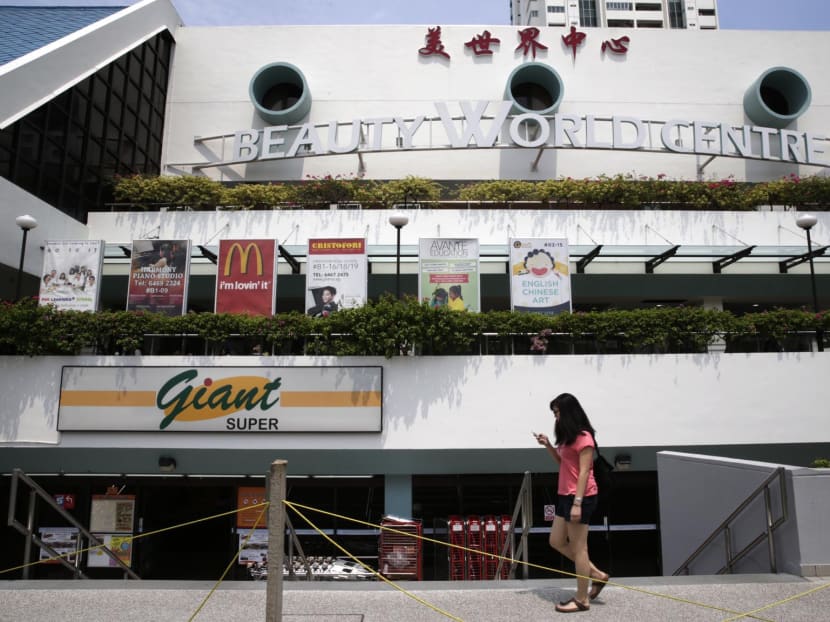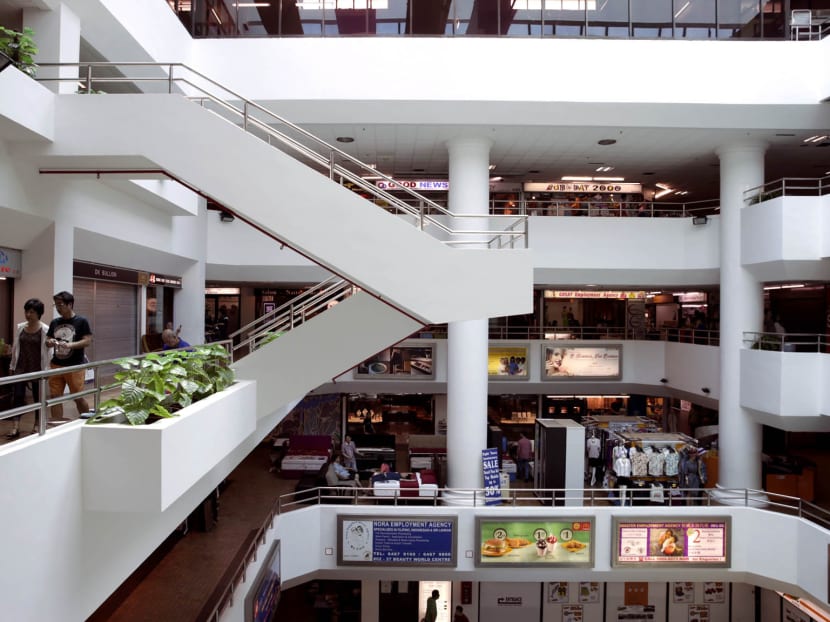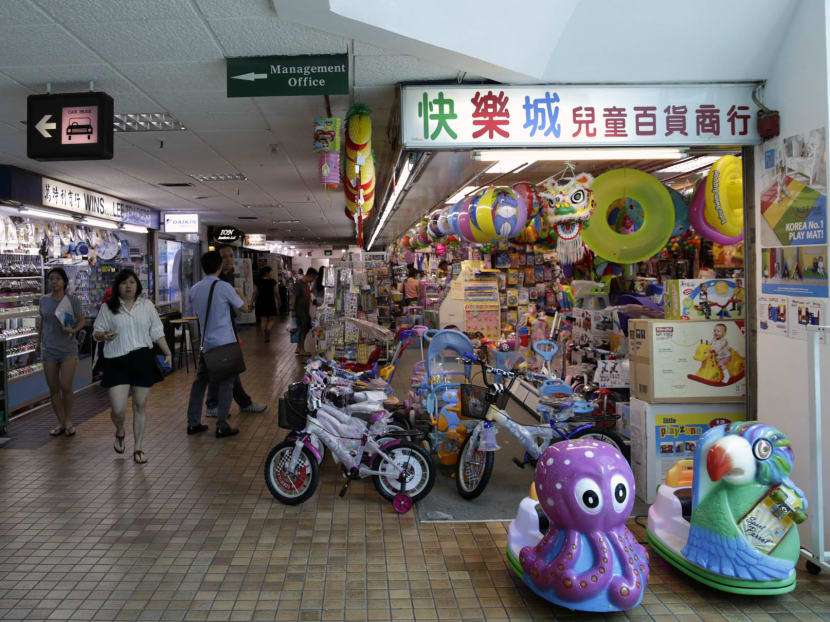Shops in strata-titled malls pull out all the stops to avoid closure
SINGAPORE — Standing in her shop in Beauty World Centre, Madam Sie Choo Yong, who is in her 90s, mustered a smile for every shopper who walked by — there were hardly any these days at the ageing mall which has become a pale shadow of its former glorious self. “Would you like a packet of crispy chips?” Mdm Sie would ask passers-by, in the hope of doing some business.



SINGAPORE — Standing in her shop in Beauty World Centre, Madam Sie Choo Yong, who is in her 90s, mustered a smile for every shopper who walked by — there were hardly any these days at the ageing mall which has become a pale shadow of its former glorious self. “Would you like a packet of crispy chips?” Mdm Sie would ask passers-by, in the hope of doing some business.
Lean Seng Lee Trading used to sell embroidery. Today, in order to survive, it sells biscuits, wafers and candies. Mdm Sie’s youngest son, Mr Tony Lean, said: “There are no buyers for needles and threads. We turned it into a food store — something easy for my mother to do. It’s not good to have her sit at home the whole day.”
The fading fortunes of Beauty World Centre — built in 1984 at a cost of S$45 million — is mirrored across the island: Strata-titled malls, where stallholders own the individual units, find themselves stuck in time and on the brink of oblivion.
According to R’ST Research, there are about 80 strata-titled malls in Singapore — many among them were household names in the past including Katong Shopping Centre, Queensway Shopping Centre, City Plaza and Golden Mile Complex, to name a few.
R’ST Research director Ong Kah Seng estimates that about a dozen are “resilient” and have adapted to consumers’ demand but at the other end of the spectrum, almost half are suffering. The ones in between are barely getting by.
The problems are strata-titled malls are well-documented: It is almost impossible to get individual owners to agree on issues ranging from collective sale to maintenance. Such malls have management councils made up of subsidiary proprietors to represent owners. Compared to institutions such as real estate investment trusts (Reits), management councils do not have strong profit incentive or the resources to keep the malls in tip-top condition.
There is also a lack of vision and coordination in terms of promotional or marketing efforts. The end result? A hodge-podge of retailers, often selling similar goods and services, housed in rundown malls in need of a facelift.
Beset with such issues, these malls face a challenge to stay relevant even in the best of times. With the retail scene currently under siege from the economic slowdown and the rise of e-commerce, the odds are stacked even more heavily against them.
Based on R’ST’s data, vacancy rates at strata-titled malls — which happen to include several of the oldest properties on the island — in the second quarter of the year reached about 10 per cent, compared to 7 per cent in malls managed by professionals.
New mixed developments including Alexandra Central along Jalan Bukit Merah and Junction Nine in Yishun are adding to the supply of strata-titled malls. Experts believe these shopping centres, including the older ones, can add to the retail scene and hold their own — if they capitalise on e-commerce, develop a niche and adapt to the changing business environment.
Indeed, some strata-titled malls —such as Queensway Shopping Centre, Lucky Plaza and Golden Mile Complex — have continued to thrive, developing a loyal following and offering an appealing alternative to shoppers put off by the cookie-cutter, glitzy shopping centres.
Apart from having a distinct character and positioning, these malls —with their lower rentals compared to shopping centres managed by Reits — offer entrepreneurs and smaller retailers an attractive option to set up a shopfront. In fact, the unit owners have a significant advantage over retailers in Reit-owned malls who are struggling with high rentals.
“The advantage of the shop owners at older malls is their brick-and–mortar presence, which is the expensive side of business. All they need to do is link it to online (operations) to pull traffic to their outlets,” said Singapore Polytechnic marketing and retail lecturer Mr Amos Tan.
For more than four decades, Mr M Nasir has been running Arcade Sports at Queensway Shopping Centre. On the changing consumer behaviour, he noted that customers these days would first do their research online to find out the range of products and the best prices before heading down to the malls. To stay in the business, prices have to be competitive but Mr Nasir stressed that service quality is key.
Compared to the footfall at swanky new malls, “people come here with a purpose — they have in mind what they want to buy,” Mr Nasir observed. “That way, chances of a customer buying in my shop is higher and we win them with quality service,” he said.
Stressing the importance of tapping into e-commerce, an owner of a mobile communications shop at Golden Mile Complex said: “Online presence is helping us survive. There is no other way to pull buyers here. But the older generation of shop owners have no idea on how to get business back on track.”
The experts said that with their proximity to large population catchments, as well as MRT stations or bus interchanges, some older strata-titled malls are well-positioned to reinvent themselves. One way to do so is by attracting entrepreneurs to their fold, they added.
Adding that these shopping centres could consider engaging consultants to come up with new strategies to draw in the crowds, Mr Ong said: “Unit owners should look at sharing shop space with young entrepreneurs. As they pull in crowd with their social media skills, other shops in the mall will automatically benefit.”
This is already happening at some malls. Mr Ryan Wee, 28, who owns Ham Baobao Burger at Beauty World Centre, told TODAY: “This place is just perfect for us. It didn’t make sense for us to set shop at a high-end mall where rents are high and survival is tough. Though the mall is old, customers come back and social media helps us bring in more.”
Associate Professor Seshan Ramaswami at the Singapore Management University suggested that unit owners reach out to budding retailers — for example, students at LASALLE College of the Arts or the Nanyang Academy of Fine Arts — and provide the shop space for them to showcase their offerings over a limited period for nominal rent, or even for free. “This will attract more people to the mall. Usually young retailers have many special concepts, and are technologically driven … If these young retailers do well, (the unit owners) can consider extending longer lease to them,” he added.






